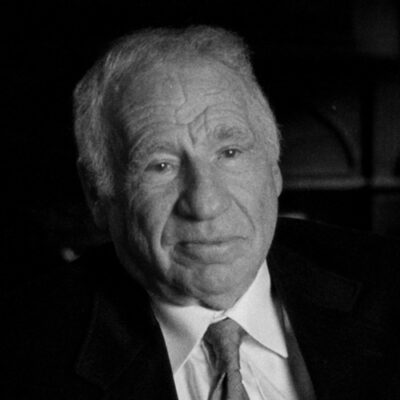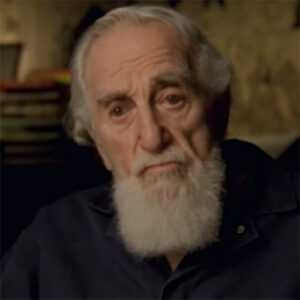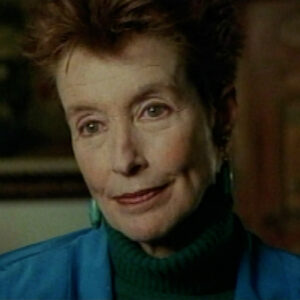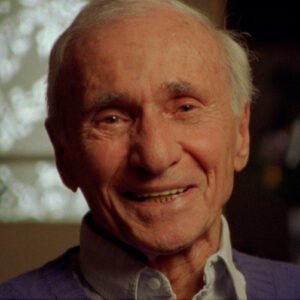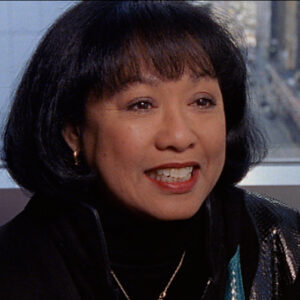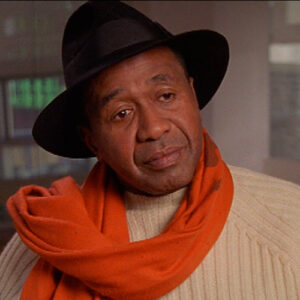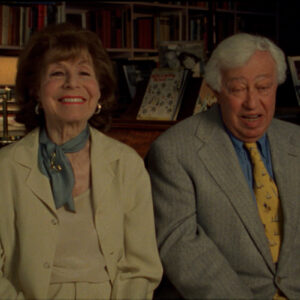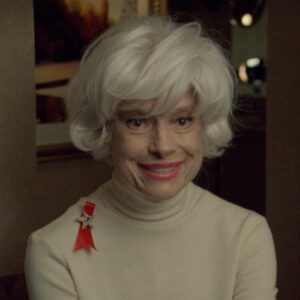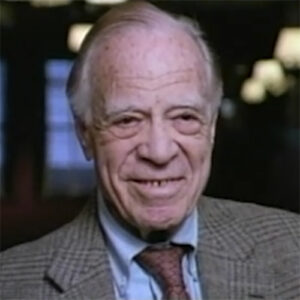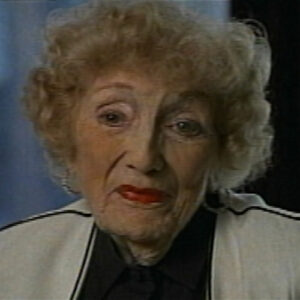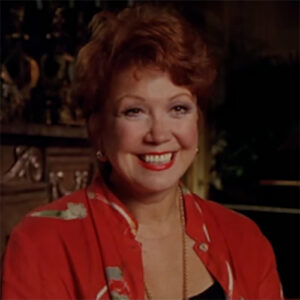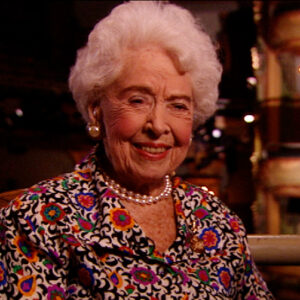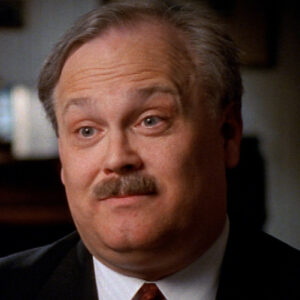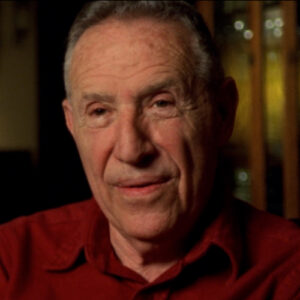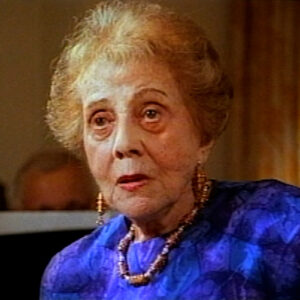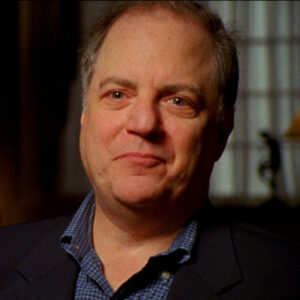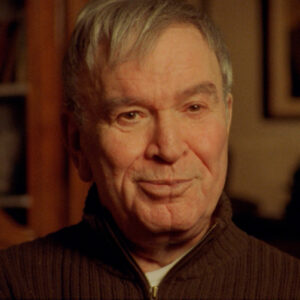Interviewer: Who was Al Jolson?
Stephen Hanan: How many answers can I give to that? Al Jolson was the greatest, the first great superstar of the American theater. He was the first personality to utilize the emerging media of the 20th century to increase not only his personal fame, but the Broadway musical as an institution. Even though they weren’t musicals in the sense that we understand it today, his shows were. Although they supposedly had plots, they were much more like reviews, kind of anything goes. Jolson himself, when he would do a show for a long run would keep changing, adding new songs. But he was the first person to develop an incredible cult of personality about the energy that he brought to the stage in a way that no one had ever previously seen. And he toured the entire country. In those days the road was still very healthy. So it was not, he would open a show in New York. Play it during the winter and then spend spring and summer and the fall touring it practically every state. I mean, he played wherever there was a theater that was big enough to hold the audiences that wanted to come see him.
Interviewer: Tell me about his background, where did he come from?
Stephen Hanan: Jolson was born in a small village in Lithuania. He was from an Orthodox Jewish family. His father was a cantor who came to America in the 1880s, I think, by himself, made enough money as a cantar to bring over the rest of the family a few years later. Jolton was the youngest of four children. And they moved to Washington, DC, where his father had a job as a canter. The synagogue in Washington where, in fact, his father was buried. And Jolson grew up on the streets. And as soon as he hit Washington, he spent a lot of time on the street. His mother died when he was still quite young, I think only eight years old. He’d been in this country for about a year. His mother was died, his mother died. His father was in the synagogue all day tutoring when he wasn’t actually dovening services and stuff. Jolson grew up on the streets of Washington and he was exposed immediately to the different kinds of music that were coming up that all of various immigrant cultures had brought to America, Italian kids, Irish kids, the black kids. He was fascinated by the movements, by dancing, by the sort of tap dancing that the black kid did for pennies and dimes and nickels, you know. And he too became a street, he started singing on the street. Um, aping. Interestingly enough, in a way that prophesied his coming career, aping the moves that he saw these black kids do, because he thought they were funky and interesting. And there was, you know, he had never seen anything like it come from Lithuania. So he absorbed all of the different strands of American culture like a sponge and went into Vaudeville at a very early age, originally in a team with his brother. But he was far more electric a personality than his brother, and he eventually went off on his own. And very quickly rose to stardom as a blackface entertainer, first in vaudeville, then in minstrel shows, which were a convention that at that point had been playing the American hinterlands in all American theaters everywhere for a good 50 years, if not more. And he brought some quality so unique to his work in blackface that he very quickly established himself as a star on Broadway.
Interviewer: Describe that unique quality, what was it?
Stephen Hanan: Well, it’s very interesting when you look at Jolson’s work in Blackface, which, I mean, every movie that he made from, starting with The Jazz Singer in 1927, on through pretty much everything he did in the 30s, throughout the 1930s. He did at least a couple of sequences in Black Face, because that’s what he was known as. And he, um… To look at Jolson in performing in blackface compared to other people, other performers of the same era who occasionally also made blackface films, it’s like day and night. It’s an incredible difference. With everybody else that I’ve ever seen wearing blackface, it’s all of the worst things that you think about blackface. It’s stereotypical. It’s demeaning. It’s patronizing. It’s just kind of, you know. With Jolsen, he inhabits. A black personality, I think, as an outsider, as a Jew in Christian America, and coming over as a boy, and particularly with the loss of his mother very early in life, he was not close to his father. He hardly knew him because his father had left the family earlier to come here. So he was a stranger and a loner, and he identified with outsiders. And um In particular, he identified a lot with black culture and he started singing, he appropriated rhythm and style and a soulfulness from black culture as he heard it, particularly when he first in his tours and his travels as a vaudeville performer, he got to New Orleans at around the turn of the century and heard the first developing strains of jazz and ragtime and he was immediately drawn to it. And he brought it to his work in blackface so that there were theaters where Jolson played and there were riots sometimes. I think it was one in Memphis, sometime in the teens because theaters were strictly segregated in those days. And the white audiences thought that a black man was on stage performing. They didn’t believe that Jolsen was a white guy in black face, they thought he was really black. And I think that’s a fascinating historical note And it’s why his His work in Blackface does not partake of that kind of demeaning thing. I mean, the institution itself is demeaning. But Jolson inhabited in a way that gave it soul and depth and dimension, which is why he became such a great star.
Interviewer: Can you just sort of explain to me what did it do for him? What did it enable him to do when he put that mask on?
Stephen Hanan: Well, Jolson was a really crazy, neurotic man. In the process of learning about him, I met people who had known him 50 years after he had died. Guys that had worked with him, you know, that long ago, and they still hated him. I mean, there were people that still, you would get, you know red in the face when they talked about the ways he treated people that he worked with sometimes. It was because he was very defensive and. Very difficult in that kind of prima donna way. So he was a man who would have benefited enormously from psychotherapy, had it been available at that time, especially because of the loss, how he was traumatized by the death of his mother at an early age. And he always looked for love, for the love that was missing when she died. And when he got into blackface… He could actually access some of that trauma. One of the things that’s interesting to read about Jolson is that he reduced audiences to tears coast to coast. Famously, he got audiences to cry. We think of it as sort of corny and even maudlin today, but in a way it also shows how poignancy has almost completely disappeared from pop culture and pop music. But Jolson was able to reach that level of it, and, you know, it was still fashionable in those days. There were other Broadway performers, Ruth Edding, for example, who made audiences cry, but very few men. And Jolsen did it by getting behind that mask and becoming someone else and saying, all right, who is the black person in America in the teens and 20s of the last century? An outsider, someone who’s disenfranchised. He never talked about that. But you could feel it from the way he sang, from the he sang about his yearning for a homeland that never existed. I mean, here’s this Lithuanian Jew from the shtetl singing about my homeland in Dixie and my lost mother. Well, of course, the lost mother was very real to him. But the homeland was a homeland of the mind, a place of, a place where my sadness would be healed. And he never would have done that in his own persona. But hiding behind the black mask, he could go there and audiences were intensely moved.
Interviewer: So someone watching Jolson’s today, they look at these clips of him and they say, my god, he’s overacting. Can you explain that to me?
Stephen Hanan: The earliest movies that Jolson made, the first, the famous sound pictures, Jazz Singer and The Singing Fool and so on are almost unwatchable today in terms of the acting style because he brought what was unique about the Broadway theater at that time to movie work and it didn’t make any sense. He, you got to remember that in Jolsen’s era there was no miking on Broadway at all. There was, and what gave it its splendor and its magic was that it was the direct live sound. Of not intervened by any kind of amplification at all. Jolson had a huge cantorial, operatic-sized voice, and he was used to pitching it to the back row of the theater effortlessly. He’d sing for hours if the audiences would let him. And, I mean, you know, they had to, you, you’d let, he’d send the other actors home. He just took everything over. But that kind of, you now, hit the backrow, hit the balcony, give, you known, the maximum energy that you possibly can. Is not necessary in movies, and it took him five years of movie flops to finally learn how to pull it back in a way that by the late 1930s he gets to be very interesting as a supporting actor in films, but it’s that kind of, we think of it as overacting now because movies have changed the way we think about acting, the close up of the camera, the closeness of the microphone. Enables you to be very soft and intimate. The same thing has happened with popular music. Crosby and Sinatra would never have had careers without microphones. So there’s, you know, all the modern singing style is about singing intimately into a microphone and the audience eavesdrops. In Jolson’s case, there was no eavesdropping. In Jollson’s cases, like, I want to make sure that you hear me over there. And so it’s about big, overblown energy. You have to get used to it, but it’s, you know it’s kind of fascinating. Things like. The difference between Michelangelo and a cartoon.
Interviewer: How big of a star was he in the 20s, teens and 20s? Tell me about his rise.
Stephen Hanan: Jolson opened the Winter Garden Theater, which was the flagship of the Schubert’s for many, many years. It’s opening night in 1912, March of 1912. In a supporting role, he stole all the reviews. Within two or three years, certainly by 1915, he played, he always had his name above the title. He was a huge box office draw. He remained that and was the highest paid performer in the history of Broadway. He was making 10,000 a week. By the early 1920s, which was unheard of, but that’s the kind of money that he drew into the box office. He remained in that position until he left to go to the movies in 1927. He then returned to Broadway, I think, for two shows. He was back in Broadway in 1930 and again in 1940, but mostly he liked the easy life of the movies. He was fabulously wealthy. You didn’t have to work.
Interviewer: Just to sort of give a sense of his power, and also because George Gershwin’s such a big character in our series, but I wanted to talk about when Jolson heard the song Swanee and decided he wanted it. You know that story?
Stephen Hanan: Well, the thing about what Joel, a great sign of Jolson stardom was that every Tin Pan Alley songwriter tried to get him to do one of their songs. And his, the way sheet music sold with his picture on it, for example, you know, guaranteed the sales of a song to such a high degree that lots of young composers, new faces would ask. Or would agree that Jolson could put his name on as a co-writer of the song so that he would earn royalties for the sales of the sheet music as well as introducing. He was a very smart businessman. It’s very interesting because in the case of George Gershwin and Swanny, that was one of the few times where he didn’t ask to be billed as a co-author. And I think it’s probably because he recognized the hugeness of Gershon’s talent in that one song. I mean, that’s the song that made Gershun’s reputation. Jolson introduced it, or Jolton made it a hit. It actually I think was done in his show by a female chorus. Joltson heard it and said, oh wait, I’m taking that. Did it as a solo and made it an enormously successful song. And, um… And he let Gershwin have all the money for it. But he was, I mean, you know, Al, Al Jolson’s name on a song guaranteed, you know, sales and popularity. He was just that huge of a star.
Interviewer: This this the song April showers when he’s singing and then he stops and he’s talking to the audience and pleading with them And then he sings some more about his style. What is he doing?
Stephen Hanan: People that saw Jolson are the best witnesses to what he was like. It’s, you learn more about his impact than anything you can get from seeing him on film. Because like so many others, like Ethel Merman and Zero Mostel, a lot of the other great Broadway performers, he didn’t translate to the medium of film. But people that saw him always said two things. I met a lot people that did. They’re still around, God bless them. They said he was the most electrifying performer I’ve ever seen. Everybody says that. Everybody says, that it’s incredible. And the other one was, when Jolson would sing, you’d think he was singing right to you. He had an ability to reach an audience, not just with the music, but with ad-libs with, he would constantly ad-lib the orchestra. His orchestra leaders would go nuts, because they had to follow every, you know, I mean they never knew when Jolsson was just going to stop and improvise a monolog. He was like all four Marx brothers rolled into one when he was on stage. No one knew what he would do next. But he had a set of signals worked out with the orchestra leader. You know, okay, I’m going to stop. All right, now I’m gonna get back into the song. But he would stop. He would do ad-libs. He would talk about current events. He was actually better known as a singing comedian than as a singer. As one of the biographies of him said, he’s much more parallel to Bert Lahr than to Frank Sinatra. He cracked audiences up all the time. He was a very witty man. And um So he would tell jokes, you know, he would have this huge operatic voice, and then very intimately we’d chat with the audience about what he did today, all kinds of stuff, and then he was hilarious. And he just held an audience in the palm of his hand to a degree that I think few people have ever done. And again, it’s like, it was what Broadway in that era could do because there was no technology intervening, no miking, no laser, no special lighting effects. It was all. Human beings up there. It was live in the best sense of life.
Interviewer: Let me sing and I’m happy, that’s sort of like, that says it all for Jolson, doesn’t it?
Stephen Hanan: Yeah, he’s, an interesting thing happened when I was studying him, a, all of his stuff is now available on CD, and I remember calling a friend and saying, you know, there is so much energy, there’s so much life in this guy’s voice, just listen to his CD, that I felt like the CD was going to jump off its cradle. It was like, there was just so much juice in it, such incredible vitality. A couple of weeks later I was reading an article about Jolson by Gilbert Seldas, who saw him a lot in the 20s, and said, Jolton’s vitality as a singer is so tremendous that listening to him on records, you feel the record is gonna jump off the turntable. And I went, well, all right, I guess it’s true. It’s just always been there. There is this, he had a vitality. There’s no other word for it. There was just more life in Jolts. And Robert Benchley once said, when Jolston walks out on stage, Even before he’s begun to sing, you feel like a buzzer went off under your seat. It was this charismatic thing, and you had to be there in the room with him to feel it. But of course, that’s what Broadway has always been about. Thousands of people all together in one room and some magnetic thing happening at a focal point that makes you feel more alive than you were when you walked in. Another thing that made Jolson a unique. Talent was he was a sponge as far as hearing stuff that was coming in the popular music, knowing what was going to be a great tune, what would be popular with audiences. He grabbed very early in his career, he took You Made Me Love You, turned it into a huge hit. He took a couple of three unknown songwriters, forgotten today, but you know, he heard, Rockabye, oh baby, with a Dixie Melody, anew. That that was just going to last, how long has it been? Seventy years that that song has still been sung and still has emotional impact. He got it from Irving Berlin who is an established guy. He heard a song from a complete unknown who was struggling to get into the business at that point and introduced Swanee and low and behold Broadway got the first song of George Gershwin. It’s very hard for us to understand blackface today as an institution. It seems so incredibly racist and demeaning and stereotypical. But I think there’s another side to it that Jolson represents, which is as an outsider in America, himself, from his own experience, a Jewish immigrant with no mother, no education, but just this great urge to sing, he felt a great kinship. With blacks and recognized their outsider role in American culture. And in a sense, to me, it’s interesting that he didn’t feel that skin color was a barrier in terms of accessing what was going on in the psyche of people who he felt that he could relate to. When he heard jazz and ragtime and those new rhythms, he instantly grabbed it up, took it in and made it his own to such a degree that Rather than being demeaning and stereotypical and feeling that he was mocking people, there was one episode in Memphis when Jolton was performing and there was a riot in the theater because in those days all theaters were segregated. Black performers were not allowed on stages and the audience in Memphis thought that they were looking at a black guy that somehow an actual negro had gotten onto the stage because Jolson was so convincing. And that’s because he felt it from the inside. He knew what was going on and to him the skin color didn’t stop him. From accessing that level of emotion. I think that’s what makes him different from everybody else.
Interviewer: The jazz singer, what was its impact?
Stephen Hanan: Well, it was revolutionary, and not so much for the singing because there had been shorts made of people singing before. In fact, Jolson did one of them. But when spoken words came out of the screen, when Jolton finishes I think it’s Tootsie Goodbye and then looks at the audience, he’s playing in a nightclub scene and says, wait a minute, wait a moment, he ain’t heard nothing yet. And this was by that time the trademark of the man who was known as the world’s greatest entertainer. He always finished every song, but he ain’t heard nothing Audiences were just electrified. They went, you know, that was unheard of. And there’s also a great scene where Jolson is improvised on camera. And it’s funny because we think of him as so stagey and so over the top. But what really thrilled people in The Jazz Singer was when he’s playing a song for his mother in her apartment at the piano and finishes the song and then turns around and just starts to talk to her. And the director just said, keep the camera rolling. And Jolton is completely improvising. This poor woman that’s playing his mother is sitting there. You can see she’s got an egg on her face. She has no idea what to say or how to respond. You know, she’s just kind of waiting for something that sounds like a cue to come in. And Joltons just going on and on and it’s so natural. And yet at the same time, it has that wonderful quality of charm that was clearly what made audiences feel that he was talking to them. Me in my seat. Me and my seat. It was not just that he was so huge, but that he was so charming and communicated so well. And audiences are like eavesdropping on a conversation. That had never happened. And really from that moment, the silent film is dead. There’s just no way that it’s going to have any life, because Jolson unintentionally showed what the medium could do in that one moment.
Interviewer: People know about his life story about losing his mother and because he sang so many songs about her.
Stephen Hanan: No, you know, it’s interesting because he was reluctant to talk about that. He was very guarded about his private life and even in The Jazz Singer, which is so clearly based on his life story, his father dies when he’s already a star, but his mother survives to sit in the front row at his opening night on Broadway and Kvel has chosen to singing all mammy down on one knee. He didn’t talk about that. I think it really, it troubled him deeply. He never really got over it, that loss, but as I said, he put it into the persona behind the mask of blackface that enabled to reach that level of emotion. But another thing, it’s, so much of the jazz singer is very obviously Jolson’s life and it would be decades until Hollywood showed Jewish ghetto life, life on the Lower East Side, tenement life. As naturalistically as they do in The Jazz Singer. It’s the thing that makes the movie, besides the fact that it’s the first talking picture, makes it such an interesting historical curiosity because it’s all of those Jews that made the Broadway musical that were largely responsible for the Broadway era and then went off to Hollywood because as Hollywood began to make musicals and they needed musical talent, well all the talent came from Broadway. Nobody else was writing songs. Nobody else is doing choreography. It was all Broadway talent. Broadway talent shipped out to Hollywood, and at that point they felt they had to pitch themselves to a wider audience. So, a lot of the Jewish stuff got kind of pushed under the rug, but not yet in the jazz singer. In the jazz singers you see, you know, stereotypical old Jews with beards and in the coat and the whole, the kind of thing, you know there’s a guy who half talks Yiddish, half English. That very quickly disappeared as Broadway became Hollywoodized. Well, another thing that the jazz singer made possible was the reaching of audiences who had never been able to see a Broadway show even when they took shows on the road with the vitality and the new sound of the Broadway musical. You have to remember that in 1927, 1928, there were still a lot of people whose favorite kind of music was operetta and the uniquely American hybrid of jazz, that… Pulled on influences from New Orleans on the one hand and Eastern Europe on the other. Irving Berlin, George Gershwin, Richard Rogers, the son of Jewish immigrants. I mean, so, you know, all refusing on Broadway to create a unique sound that became what we think of as jazz. And particularly that Broadway, that special Broadway jazz sound that. The minute, I mean, when Jolson got down and sang some of that stuff with that vitality and with the wonderful orchestrations of that era, the popularity just soared and suddenly that was the music everybody wanted to hear. Broadway composers, Broadway choreographers, Broadway directors, and certainly above all Broadway singers and dancers, move out to Hollywood in droves and that becomes the idiom of American popular music. Through the medium of film. I mean, you had records were made of individual Broadway songs and stuff and shows. It was years, I think, not until Oklahoma that you had a complete cast album. But individual performers made those songs popular, but it was the movies, Broadway melody, this kind of Broadway review, all of the, Henderson, Brown, De Silva singing in the rain. These songs just suddenly became what all America was listening to and then all the world. So that by the 1930s, jazz is triumphant. Suddenly there’s no, I mean operetta seems terribly old-fashioned and this new kind of music that’s cradled on Broadway comes into its full maturity with the Hollywood musical with using Broadway talent. Another thing that was unheard of before Jolson came along in his talent was for somebody used to an operatic-sized voice which he had, huge, but in a casual conversational way with this non-operatic music. For example, when Jolson would sing and he does this on several versions of the song and different records over a period of 20, 30 years when he goes, California, here I come, yeah, right back where I stand. I mean that yeah is so, remember the first time I heard it was like he’s there in the room. I think that’s the thing about why I felt that the disk would flip out of its cradle. It’s like the man was there, not just a singer, not just the beautiful voice, but a personality that was, a whole being communicating through song but exclamations of joy and just ecstasy when music was not enough to carry it. There would be, in a sense, he was like a rock singer before there was rock music. He would use everything in the vocal arsenal, not just notes and rhythm, but these cries. He’s talking to the audience. Laughter. Yeah, emphasis. Just, he was just completely on and unpredictable. You never knew what would happen next. You know, I think the first British musical that made a really major hit on Broadway was Oliver. But what people think of as a British invasion per se, begins with, it’s synonymous really with the career of Andrew Lloyd Webber, Evita, Cats, then Phantom of the Opera to name but three. It’s, suddenly the British found a way of making a kind sung through musical. That was operatic in style, but used contemporary pop sound. And there’s no spoken dialog. The whole kind of Rodgers and Hammer, I mean Oliver is still a Rodgers and Hammerstein style musical. Scene, song, scene builds to an emotional climax, you follow with a song. Then you start up again with another spoken dialog scene. In Evita, in Cats, in I think all of Andrew’s musicals, you just sing nonstop through. It’s this whole other feeling. And… And it’s in a pop, kind of Euro pop contemporary sound. And audiences loved it, totally loved it.
Interviewer: Who was Andrew Lloyd Webber, briefly?
Stephen Hanan: Angeloid Webber figured out this is so difficult to answer. Andrew Lloyd Webber turned into the phenomenon of the 80s and 90s musical theater by dipping back into the kind of Puccini-esque style of finding a melody with an incredible emotional hook that, you know, what I think Richard Rogers once said about musical theater that the audience doesn’t have a second chance to decide whether they like the tune. You know, whether it’s Verdi or Mozart or Rogers or Lloyd Webber, there’s something about the arrangement of notes that once you hear it, it’s like it’s lodged in your mind. Jerry Herman has that skill. It’s, and I, but what Andrew did was take that melodic richness and melodic accessibility and wed it to both the sense of stage spectacle and contemporary pop orchestral sound. Which was a hybridization. I mean, Broadway’s always about hybrids. It has always been about drawing strands from different parts of the culture and putting them together on a stage and making them work as you tell a story, whether it was with the first Broadway hits of the 20s and 30s. And Andrew did the same thing, only he was drawing from different sources. I saw my first Broadway show when I was 12 years old, and I don’t remember a lot of details, but I remember what it felt like when Ethel Merman came walking down the aisle with that voice. And that energy, and I was in the room with that person, that amazing, special person. I hadn’t seen the show in London, and I don’t think I’d even heard the cast album when I got into the show. I had no idea what we were in for on the first day of rehearsal. The thing I knew about Trevor Nunn was that he had directed Nicholas Nickleby, which was just this incredible theatrical masterpiece. And it turned out that the whole first week of rehearsals was devoted to improvising about being a tribe full of cats, a room full of cats. We didn’t work at all on the script. We learned the music, but we didn’t block any scenes or anything like that. It was just about observing life from the point of view of a cat. What it’s like when you’re on all fours all the time and looking at the floor and stuff that’s on the floor, and other noises and other sounds, and transforming your consciousness in a room full of other people who are doing the same thing. And in fact, I guess one sign of how successful it was under Trevor’s guidance is that one day after rehearsal, three or four days into it, I went to visit a friend of mine who had several cats in her apartment. And they all started rubbing up, and they knew me, I mean, I’ve been there many, many times, but they all started rubbing up against my legs in a very curious manner. And Sarah said, do you see what they’re doing? I said, yeah, it’s kind of weird. What is it? And she said, that’s always the way they behave around people who’ve been around a lot of cats. And I was like, okay, well, I guess we’re picking up something. The thing that Trevor really worked at in directing us as actors in this show was, because I mean, here you have this, as he said on the very first day, we have this incredible problem. You’re, you know, you’re human beings and you’re pretending to be cats now. But are you pretending? You know, good acting is not about pretending. Good acting is about being and experiencing. So in addition to the improvisational work about what is it like to live life on all fours with all this other stuff going around. A great deal of it was fusing the range of movement that’s available to animals. I remember, for example, in the very earliest work on Gus the Theater Cat, I used to hold up my forefinger a lot to make points. And Trevor would say, you know, human beings don’t do that. Cats don’t have forefingers. And you know you can take that literally only so far, but there was a deeper intention underneath it. And that was the great thing to explore as an actor was, Okay, given whatever limitations this physical form might be and it would be the same. You know, you have limitations no matter what you’re playing. Whether you’re play, you know, somebody in Chekhovian Russia or somebody in Restoration England. There’s still a way of being that you can’t go outside of. You can’t suddenly be hip hop in Chekov, Russia. So here was just a little kind of more intense way of saying, okay, I’m a cat, I am speaking English and I’m speaking actually the English of T.S. Eliot. And expressing very human emotions, particularly in the case of Gus, an old derelict who remembers the old days with nostalgia. Are cats nostalgic? I don’t know. Cats live a lifetime considerably shorter than that of human beings, but within that, we don’t that they look back. You know, what is it like for an old cat to see a kitten? Say, okay, this is the same species as I am, but a much earlier stage of the journey. And there’s a way that as a human being you can say, I can play that. I can that in a way will be recognizable to an audience as an emotion that they, too, have felt and yet still adhere to something feline. And that’s what made the show magical. That’s what make the show the hit that it was. I don’t think it was the technology. That kept it running over the years and the years and the year, particularly audiences that never spoke English. She didn’t matter so much as long as. You know, all these great lights and hydraulic things were happening. But in the earliest stages with the original cast that had all of the time to do that work together, there was a kind of telepathy that we all shared about, yes, we all know that we’re human and we’re talking, which cats don’t, and yet we’re grafting that onto something that you wouldn’t think would be possible. And our conviction that we could do it is what made audiences believe it and go into this kind of magical amusement park ride. And I think that’s what made the show reach people in their millions as it did.
Interviewer: Tell me about the amusement park, Ryan Park, tell me about John Napier and what he did to the Winter Garden, just briefly.
Stephen Hanan: Well, the shell of the theater was completely transformed. There had been, you know, stuff spilled off the stage onto, first of all, you read, you the proscenium all but disappeared. You couldn’t tell where it was. All the junkyard theme that was on the set spilled off into the house, up onto the ceiling, up the aisles. And it was a wonderland. No one had ever seen a show, a set like that before. It was unique.
Interviewer: So people who dismiss cats as mere spectacle, how do you respond?
Stephen Hanan: I had done one Broadway show previously, the Pirates of Penzance revival, when Cats came along in 1982. And I was lucky enough to be in the original cast of that. And I remember the first day that we moved from the rehearsal studio into the Winter Garden, which had been completely refurbished. We all sat down in the orchestra seats and Trevor had John Napier, the set designer, run all of the tricks that the set did, all the hydraulic stuff, the lighting effects, of stuff that. You know, a level of spectacle that had never previously been seen on Broadway. And at the end of it, we just burst into applause. We just sat there with our mouths open like, we’re just unheard of and certainly unseen. And Trevor said, you remember all the time I’ve been talking in rehearsal that the main focus of this show is to allow audiences to experience once again what it’s like to be little children. Now you see. And now you as actors will participate and help them along because the set will help you to achieve that result. So what we realized at that point was the show was about wonder more than anything else. It was about creative and I think, you know, that’s a very noble thing to give an audience, to be able to transform into a sense of wonder. Spectacle has always been a part of the theater and it’s very easy to dismiss and I frequently dismiss it myself. You know, I love it when you can ally spectacle with content, then there’s nothing better. But sheer spectacle, if it’s done with intelligence and with style, can evoke a sense of awe, a sense of wonder that’s almost religious. And remember, I mean, the theater started as a religious institution. It was, and for that, to transport people out of the ordinary workaday world into something of fantasy, of wonder. I can’t avoid that word. It’s a great thing when you can do it and it makes the world a much more beautiful place.
Interviewer: And cats, do you think cats did that?
Stephen Hanan: Well, from the very first audiences that walked into the theater, you could see that we had succeeded in that respect. They were, they did get like children. I mean, you would stand out there on the stage and watch, you know, very sort of harumph type business people and their, you know very fine, they had their best theatrical duds, you now, were just like sitting there like. Night after night after night, you know, and you felt, we’re giving these people a gift. This is a gift, to let people touch that part of themselves. This is very important. Since I was in the original cast of Cats, I got invited back periodically over the years as they passed milestone after milestone. I think first when they ran nine years, the ninth anniversary they had a big party that was sort of like connected to nine lives of Cats. Then when they surpassed the run of Chorus Line to become the longest running show and finally when it closed after just about 18 years. And it was amazing, I think no one imagined. Any of us that started out with it, you know, is just like a show that we’re putting together from scratch in a rehearsal room. Yes, they had done it in London, but here’s the whole New York thing. And I subsequently learned from both Trevor and Cameron McIntosh that its debut on Broadway was very, very significant to them. Even though they had a hit in London Broadway still remained sort of the acme of everything, even for these like, you know terribly skilled and successful British guys. Broadway was the end all. And they didn’t know how the show would go over on Broadway. Would it reproduce the kind of success it had in London? Not only did it reproduce it, it went way beyond it. It enabled Cameron to start this whole string of musicals that became not just passing shows of the big hit of the season, but worldwide corporate phenomena with a logo that was recognizable from Tokyo to Johannesburg. You know, he did it with Phantom, with Les Mis as well, you know. It turned out to be, I mean, the marketing skills of shows like this became as important as the actual content and the material. And while, of course, it made millions and hundreds of millions of dollars for people, it also, I think it lost a little something of that initial Broadway hit of, well, none of them were star vehicles, for one thing, so it wasn’t like being in the room. With Ethel Merman or Zero Mostel or Mary Martin or Robert Preston with like, it came less and less to be because naturally because you were having a global phenomenon, a corporate phenomenon that you had to be able to reproduce in Norwegian, you know, in German. Cameron McIntosh realized before anybody else that shows could be marketed in terms of the emerging global culture. That a show could become a franchise and be done all over the world. And, you know, he’s had enormous success with that, but it has definitely impacted the kinds of shows that get done and the quality of the theater-going experience, because when a show has a recognizable logo anywhere in the world and has to be capable of being performed in Norwegian. And Spanish, and Tagalog, and English as well, you know, God knows what else. It’s no longer about personalities, the kind of, the kind larger than life, but still human magic people that were the original engine of the Broadway musical, Jolson, Merman, Fred Astaire, you know. That’s Robert Preston, Mary Martin, Azearo Mastel. There, that shows. You can’t do that anymore because you can plug it into the different markets that you have to go to and know that there will be someone uh… Who’s unique in that way so uh… I think shows have somewhat suffered from that because audiences get a very different kind of experience it’s much more like going to a theme park in a way and you get assaulted by a lot of terrific visual spectacle you have the disney shows have now done brought this to a high degree of our artistry uh… You know i’m not knocking it entirely it’s it’s but The human aspect has been dwarfed by the scale of the necessity of making shows global hits.
Interviewer: There’s a moment in the rehearsal when you talked about the first time you heard Andrew Lloyd Webber play Memory and Trevor Nunn said that’s the kind of melody that makes emotion burst open too powerfully to be merely sentimental. Can you just tell me about what it was like as someone who’s going to be performing in the show to hear that song?
Stephen Hanan: The very first day of rehearsal of Cats, Andrew Lloyd Webber sat at the piano and played through the score, or most certainly the highlights from the score. And, of course, the big moment was when he played Memory. And, I mean, I remember how thrilling it was. It was just, it was astounding. It was so beautiful. It was powerful. There was no surprise that it went on to become this colossal hit song. Going back to what I wrote about it in my journal at the time that, you know, how. I think, as Trevor said, the emotions that it lifted were too powerful to be merely sentimental. But I did that show for 15 months, and I’ll tell you, 700 performances into it, it was kind of, you know, the thing about doing a long-run show, it’s like a love affair that goes bad, and you find yourself thinking, this used to be great, what happened? You know, how did I get bored? How come I don’t like this anymore? And that’s just the nature of the beast. That’s why they replace people. People often ask, you know, standing on a Broadway stage and getting an ovation, how does that feel? What is that? You know, is it just, I mean the initial reaction is always just to have that many people letting you know you know sending you all that love. It’s a great thing. There’s certainly nothing quite like it. And at the same time, it’s also applause is a barometer. You can learn a lot from, you know, applause comes in different flavors. And you learn, especially if you get used to it, if you get used a very full-tilt response to something, and then it’s not so good, you think, hmm, OK, did I get this wrong, did somehow not communicate as fully as I can, or was it the audience? One of the amazing things about Broadway always is that the quality of audiences can vary. And I’ve always wondered, how can it be that 1,500 people will be sitting in a room, and they’ve bought their tickets in different places at different times, They’ve converged. Into one location from all over the place, all over the country, sometimes all over the world, and yet, they will have a distinct personality, somehow. I mean, how can that possibly be? Why aren’t they all average? Why aren’t t they all random? And they’re not. Sometimes you have really great audiences, and sometimes you have audiences that are, you know, like, very lukewarm, and you sort of wonder, how could that be? And it’s because it’s a very holistic experience. It’s different and new every time you do it, no no matter how. Sick you are of it, no matter how long you’ve been in a run and repeated the performance, for the audience it’s new and they will let you know by the applause how much they’re getting it. So even when they love you or even when the hold their love back, they teach you something and that’s the thrilling part.
Interviewer: Mo, can you tell me about the impact of…
Stephen Hanan: Hmm Yeah, when people talk about AIDS, and it’s interesting, Katz was rehearsing in the summer of 82. It had been just about exactly a year since the first news of it broke in that famous New York Times article. And looking back on it, a lot of people talk about the great talents that were lost. Michael Bennett, for example, perhaps the most outstanding example. But, you know, when I think back on it, the… The people who might have become famous, a dancer like Tim Scott, just a brilliant supporting performer like Renee Clemente. You know, not the great names that people go, oh my God, what the Broadway theater lost because he died. So many people from the ranks, you know, the thing about AIDS, it didn’t just get the generals. It got the privates. It got guys in the trenches. And, um… At the same time, you found yourself feeling really lucky to be alive and grateful. But many, many is the performance that I’ve given where I felt, you know, wish that Tim could have been on the stage with me. I perform now as an actor on the shoulders of people who are no longer here that can no longer give their gift to audiences. So in a certain extent, I try to give it for them. It’s not easy.
Interviewer: Why should we care about the Broadway music?
Stephen Hanan: The Broadway musical is, caring about the Broadway musical is like caring about America. The Broadway Musical, since its inception and over the years has drawn in in the way that America does, every possible strand in the culture. There have been times when Broadway musicals were frivolous entertainments that helped people get through the dark days of the Depression. There have been times when the Broadway musical addressed the political and cultural transformations that were going on in the era of hair, or for that matter, the Rodgers and Hammerstein stuff right after the Second World War, conveyed and told the popular culture as perhaps no other one had as successfully as immediately that America was stepping into the world in shows like South Pacific and The King and I, that we were moving out into a bigger world, we were no longer the isolated country. And it feeds back from other countries, you know, we see that Fiddler on the Roof is played in Japan and the Japanese say, well, it’s very much about a culture reeling under the impact of a new world that’s challenging tradition. We like it, we don’t understand why Americans like it. You know, so it reflects us. You know I mean, Shakespeare said the theater holds a mirror up to nature. In the case of the Broadway musical, like it’s a fun house mirror, but it’s still a mirror.
Interviewer: So why does the Broadway musical matter?
Stephen Hanan: The Broadway musical matters if America matters, because they’re really one and the same. You know, from its inception, the Broadway musical has drawn in from all of the aspects and facets of American culture to synthesize them into one art form that’s popular and at the same time artistic, that talks to people’s lives. In the Depression, it lifted people out of their sadness and gave them an image of a more joyful world. After the second world war with Rodgers and Hammerstein, it showed us America stepping out onto the world stage. It then reflected political and cultural changes with the era of hair. And in addition, it’s gone all over the world and shown them a picture of who we are. The Japanese made Fiddler on the Roof an enormous hit over there and they said, well, here’s a show about a traditional culture reeling against the impact of modernism. We understand it, but we don’t understand why the Americans like it it’s in its most universal aspect of joy as well as originality and energy it’s it shows the rest of the world and ourselves who we are like Shakespeare said it’s uh the theater holds a mirror up to nature and the Broadway musical is a funhouse mirror
Interviewer: What are you thinking to do for it?
Stephen Hanan: I hate it. You know, when he came to Broadway in the 1920s, the English critic G.K. Chesterton said, Times Square would look like paradise to anybody that couldn’t read. And unfortunately, I can.
Interviewer: That’s great.
Stephen Hanan: I’m sorry if you liked that.
Interviewer: What adjectives would you choose to describe, you know, generically the Broadway music?
Stephen Hanan: Joyous, energetic, wondrous, fun, loud, catchy, popular. Memorable. Important. Essential.
Interviewer: Um. What do the musicals we’ve loved over the years say about us as a country?
Stephen Hanan: Broadway musicals do, in an American idiom, what opera does, which is to say, there are times in our lives when we feel emotions so powerfully that talking isn’t enough and you have to burst into song, or you have start dancing, or do somersaults. Because as human beings, we feel so deeply that spoken dialog can only represent a very small part of that. And the musicals… Give us a much wider palette.
Interviewer: Um Just one thing, Broadway is a collaborative art form. Just speak to that, maybe it’s the most collaborative or it’s intrinsically collaborative. Speak to your experience in terms of collaboration.
Stephen Hanan: Yeah, every musical I’ve ever done, the collaborative element has been the most important part. I mean, the most fun for me, because I love it. I love sitting on the side of a rehearsal room and watch other people be great, do extraordinary things, frequently things that I could never do, and sit there thinking, my god, and they pick me to be in the show with them? Wow. And also makes you want to do your best. It’s funny, because. A lot of people in our culture think that competition brings out the best in people. And my experience of doing Broadway musicals is that cooperation brings out the best and people. You see something really great and you say, I want to be that good, you know, and have us all be that together. Plus don’t ever forget that the collaboration of the Broadway musical also involves the audience. The audience is 50% of the equation. They bring their life and whatever they, wherever they’ve come from that day into the theater. And somehow, everything that we’ve prepared has to reach out to them and get them to come back and start applauding and say, yes, I recognize that. I recognize, that that moved me, that thrilled me. Thank you. And we thank them back, and that’s collaboration.
Interviewer: Describe the intensity of the risk on Broadway. Broadway is a place, unlike the very few other places where the stakes are that high. It’s sort of human frailty, like a golfer doing a putt and what have you. It’s very intense.
Stephen Hanan: It’s the intense thing of, I mean, because it’s just like the difference between somebody walking out on stage that you’ve never seen and they give a terrific performance and it’s like, oh wow, there’s a discovery. As opposed to Luciano Pavarotti or Ethel Merman walks out and before they even do anything, you’re like thrilled because you know who they are. That’s what Broadway is. Because a show is on Broadway as an audience member, you attend it in a different frame of mind. And as a performer, You step out on that stage in a different frame of mind. It’s not just a stage. It’s Broadway. It’s got generations of excellence standing behind it. You know, you wanna reach that level. You wanna be worthy of that tradition. I did my first Broadway show in 1981, Pirates of Penzance. It was actually the same season that 42nd Street opened. And now 23 years later, there’s a revival of 42nd street on Broadway. And of course, Pirate’s was a revival too, but after a hundred years. I wish the Broadway musical had evolved in a different way if it were up to me. I would have liked to see the tradition of lyrics That’s embodied in Cole Porter and Frank Lesser have continued to grow. I would have liked to see less amplification. I wish shows could still survive without as much miking as we have. I wish there were alternatives to the rock musical, that there was still room for a lot of different kinds of music. And I wish that the stories were more about people. And the part that we play in the world and less about machinery and spectacle.
Interviewer: Broccoli grappling with the changing.
Stephen Hanan: I was in college in the mid-60s, and it was like, we didn’t realize it at the time. It was the sunset of the old-style Broadway musical that came in with Rodgers and Hammerstein. I remember the day that I registered in college, Fiddler on the Roof opened on Broadway. And I was kind of, I had seen it as in the try-out tour in Washington, thought it was amazing. And I thrilled that when I graduated, it was still running. That was the era of Fiddlers on the Roof, Man of La Mancha. I mean, these kind of romantic book shows that… You know, the old style orchestration, the old-style of very limited foot miking. And that changed radically with the advent of hair. You know, first rock musical, I think, or certainly the first one on Broadway. And rock music was changing the nature of popular music. Broadway had to respond to it. It was incredible. And that it managed to do so was amazing to me. I remember seeing a company. Trying out in Boston, I think it was 1970, and it was like nothing anybody had ever seen. I think probably seeing Oklahoma when it was brand new might have been comparable to the experience of seeing, you know, being in your twenties and seeing company and going, boy, they’ve invented something completely new that the musical has never done before. It was so about the world, the new world that we lived in. It wasn’t a rehash, not to say that those other shows were, but it was just absolutely new responding to the time, like hitting its stride and going, this is where we’re going. And it did. It was amazing. I mean, it was funny to think that the opening number of Fiddler on the Roof tradition was actually about the closing of an era of a Broadway musical that the curtain rose on Fiddler, but it came down. On that kind of show.

